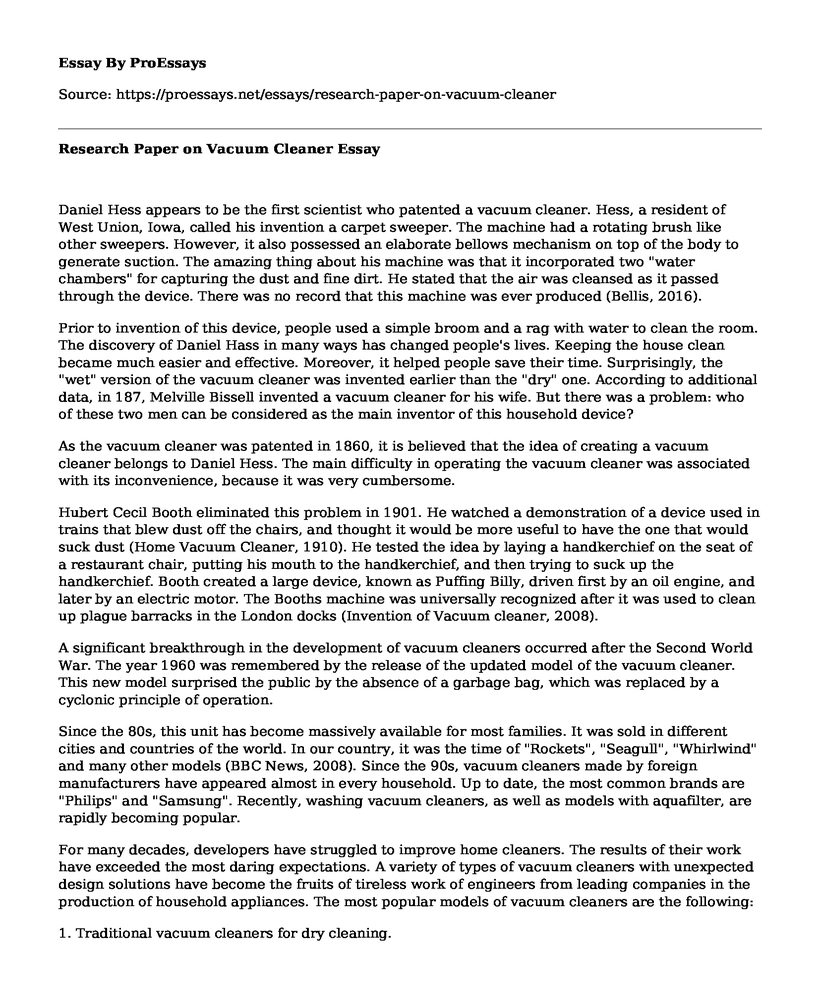Daniel Hess appears to be the first scientist who patented a vacuum cleaner. Hess, a resident of West Union, Iowa, called his invention a carpet sweeper. The machine had a rotating brush like other sweepers. However, it also possessed an elaborate bellows mechanism on top of the body to generate suction. The amazing thing about his machine was that it incorporated two "water chambers" for capturing the dust and fine dirt. He stated that the air was cleansed as it passed through the device. There was no record that this machine was ever produced (Bellis, 2016).
Prior to invention of this device, people used a simple broom and a rag with water to clean the room. The discovery of Daniel Hass in many ways has changed people's lives. Keeping the house clean became much easier and effective. Moreover, it helped people save their time. Surprisingly, the "wet" version of the vacuum cleaner was invented earlier than the "dry" one. According to additional data, in 187, Melville Bissell invented a vacuum cleaner for his wife. But there was a problem: who of these two men can be considered as the main inventor of this household device?
As the vacuum cleaner was patented in 1860, it is believed that the idea of creating a vacuum cleaner belongs to Daniel Hess. The main difficulty in operating the vacuum cleaner was associated with its inconvenience, because it was very cumbersome.
Hubert Cecil Booth eliminated this problem in 1901. He watched a demonstration of a device used in trains that blew dust off the chairs, and thought it would be more useful to have the one that would suck dust (Home Vacuum Cleaner, 1910). He tested the idea by laying a handkerchief on the seat of a restaurant chair, putting his mouth to the handkerchief, and then trying to suck up the handkerchief. Booth created a large device, known as Puffing Billy, driven first by an oil engine, and later by an electric motor. The Booths machine was universally recognized after it was used to clean up plague barracks in the London docks (Invention of Vacuum cleaner, 2008).
A significant breakthrough in the development of vacuum cleaners occurred after the Second World War. The year 1960 was remembered by the release of the updated model of the vacuum cleaner. This new model surprised the public by the absence of a garbage bag, which was replaced by a cyclonic principle of operation.
Since the 80s, this unit has become massively available for most families. It was sold in different cities and countries of the world. In our country, it was the time of "Rockets", "Seagull", "Whirlwind" and many other models (BBC News, 2008). Since the 90s, vacuum cleaners made by foreign manufacturers have appeared almost in every household. Up to date, the most common brands are "Philips" and "Samsung". Recently, washing vacuum cleaners, as well as models with aquafilter, are rapidly becoming popular.
For many decades, developers have struggled to improve home cleaners. The results of their work have exceeded the most daring expectations. A variety of types of vacuum cleaners with unexpected design solutions have become the fruits of tireless work of engineers from leading companies in the production of household appliances. The most popular models of vacuum cleaners are the following:
1. Traditional vacuum cleaners for dry cleaning.
2. Washing vacuum cleaners.
3. Vacuum cleaners with aquafilter.
4. Vacuum cleaners-steam cleaners.
5. Separator vacuum cleaners.
6. Built-in vacuum cleaners.
7. Vacuum cleaners-robots.
Speaking of the latest variety of dust-collecting equipment, it is worth noting that the first robot vacuum cleaner appeared by the efforts of developers from the company Electrolux. In 2002, consumers were given the opportunity not only to admire this intellectual gadget, but also to acquire it for personal use. Perhaps, modern robot vacuum cleaner for today is radically different from its long-standing predecessors (History of HMI Industries, 2012).
Nowadays, a modern house is difficult to imagine without a vacuum cleaner. Now there are so many varieties of this home assistant. Modern portable vacuum cleaners resemble amazing robotic machines from fantasy novels. They can move without the help of a man, tactfully bypassing furniture and people, splashing pleasant aromas around the rooms and sucking saprophytes. Nevertheless, this is still not enough for us. Adapting to our needs, day after day these irreplaceable helpers get better.
In a word, the evolution of the vacuum cleaner demonstrates the growing technical and scientific progress. A modern vacuum cleaner is a quintessence of massive work of several great inventors who gradually made their ideas serve the aim of the development of irreplaceable adaptation in modern houses.
References
Bellis, M. (2016). Hooner Vacuum Cleaners. Journal of International Consumer Marketing, 10(3), 85-113.
Home Vacuum Cleaner (1910).
Vacuum Cleaner (2007).
Invention of Vacuum cleaner (2008).
BBC News. 27 January (2008). "Vacuum cleaner lasts for 70 years". Retrieved 28 January 2008.
HYPERLINK "http://www.fundinguniverse.com/company-histories/HMI-Industries-Inc-Company-History.html" History of HMI Industries, Inc. FundingUniverse (2012).
Cite this page
Research Paper on Vacuum Cleaner. (2021, Apr 08). Retrieved from https://proessays.net/essays/research-paper-on-vacuum-cleaner
If you are the original author of this essay and no longer wish to have it published on the ProEssays website, please click below to request its removal:
- Letter About Relationship Between Copper and Zinc
- Biography of Isaac Newton
- Theory of Probability Paper Example
- Research Paper on Construction Falls
- Research Paper on Novel Use of Drone Technology and 3-D Numerical Modeling
- Civil Engineering & Public Works: Building Bridges, Ports & Road Networks - Essay Sample
- Paper Sample on UDL-Transform Math Course Syllabus for Student-Centered Learning







